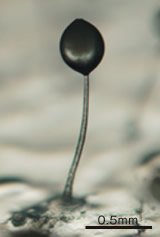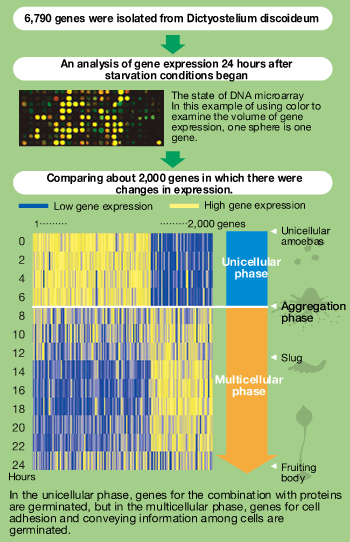Research
A backstage look at becoming
multicellular using cellular slime molds

Our first step in understanding the differentiation of function among cells was to comprehensively collect DNA from cellular slime molds, and then conduct a DNA microarray analysis using DNA microarray. As a result, we discovered there was a difference in the great majority of functioning genes between the unicellular phase and the multicellular phase. Most of them began to convert when the cells began to aggregate. To live as a multicellular body requires making functional roughly the same amount of genes necessary for the unicellular phase. The cellular slime mold prepares for starvation that may come at any time by maintaining within the genome the genes required for cell differentiation even during the unicellular phase, and continues to replicate them. There is a burden from the energy requirements for maintaining and operating so many genes, but this is the form arrived at after a process of trial and error for creating descendants and avoiding the extermination of the group.
Meanwhile, some slime molds do not differentiate cell function even when the cells aggregate. These are called Acytostelium, and they branched off before Dictyostelium discoideum appeared. The cells become spores to survive in conditions of starvation. If we could compare the functions of the gene varieties in both types to identify the mechanism for the differentiation of cell function, we might understand the multicellularization process.

After receiving a doctorate in science from Kyoto University in 1979, Prof. Urushihara taught at the Mitsubishi Kagaku Institute of Life Sciences until 1981, the Cancer Institute of JFCR until 1983, and the National Cancer Institute at the National Institute of Health in the U.S., as well as Riken, until 1985. She has been a lecturer in biology at the University of Tsukuba since 1986, and a professor at the same university's Graduate School of Life and Environmental Sciences since 2004.
- Dialogue:What is RNA? An ageless worker with information and a function
Yoshikazu Nakamura / Keiko Nakamura - Research01:A backstage look at becoming multicellular using cellular slime molds
Hideko Urushihara - Research02:Lions as a symbol of other
Kazuyoshi Sugawara - Scientist Library:Looking at plants, asking plants
Hiroh Shibaoka
|
|